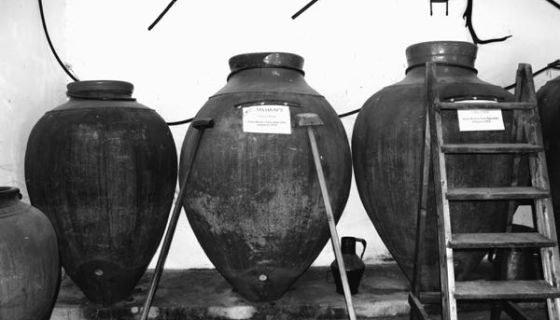From $19.99, £21.95, 150 Brazilian reais
Since the end of July I have been waiting for these two wines, a red and a white, to land in the UK. I'm delighted to say that they are now available in the UK, the US and elsewhere (see full details at the end of the article).
Bojador is the personal project of Pedro Ribeiro, winemaker at Herdade do Rocim in Portugal’s Alentejo, and it was the 2015 vintage of the Bojador Vinho de Talha white that first attracted my attention, so much so that I presented it at a tasting in Lisbon designed to show the current diversity and innovation of Portugal’s winemaking.

Innovation is probably the wrong word, since both the red and the white are made in talha (top right), the Portuguese equivalent of a clay amphora. Vinho de Talha are traditional in the Alentejo region and now also have their own classification within the Alentejo DOC. The talha used by Ribeiro have no lids but the wine is protected from the deleterious effects of oxygen by a layer of olive oil.
The vineyard in the Vidigueira subregion of the Alentejo, which has a continental climate but is the most temperate part of the Alentejo, is also traditional: an organic field blend of old bush vines (pictured) of red grapes (Trincadeira, Moreto and Tinta Grossa) and white grapes (Perrum aka Pedro Ximénez, Roupeiro aka Síria/Códega, Rabo de Ovelho and Manteudo), though the red and white varieties are harvested separately for a red and a white wine – but all grapes of the same colour are co-fermented.

The red, the result of fermentation with indigenous yeasts in earthenware jars without temperature control, with no addition or correction to the juice or the wine, and no stabilisation (potentially resulting in some harmless sediment in the bottle), has resulted in a wine I described in the following way:
'Light to mid cherry red with a lightish rim. Charming, fragrant red-fruited aroma with wild, sour notes of little red berries along with a delicate smoky sweetness. Fine grip in the texture here, perfectly married to the fresh acidity and juicy fruit, giving intensity without weight. Irresistible, pure pleasure. Long and mouth-watering and still well-structured enough for food. Succulent, long and only 12.5%.'
Even though the grapes are destemmed – it would be impossible to work with whole bunches in these fermentation vessels, says Ribeiro – the stems are put into the bottom of the talha to act like a filter when, after fermentation, the wine is drained off through a tap at the bottom of the vessel, which you can just about see in the photo top right. The inclusion of the stems adds tannin and increases the wine's ageing capacity, he explains.
The white, vinified in the same way, on the skins and with the stems at the bottom of the talha, is equally impressive, and although it has a firm and food-friendly texture, it is not as tannic as some whites that have been fermented on the skins. Here's my tasting note:
'Pale gold and very slightly cloudy. The aroma is utterly seductive: even though it is a dry wine it smells of just-ripe apricots and oranges, lemon curd, the fruit smells so sweet and you'd almost think there was some botrytis influence here. Gloriously inviting. On the palate, this is bone dry yet fills the mouth with rich, generous fruit and has all those lovely flavours that match the aromas and yet such modest alcohol (12%). This is a remarkable and delicious wine with both weight on the palate and wonderful freshness, enhanced by a light sour note on the finish. There's a firm texture and a long fresh finish.'
Ribeiro obviously gives a lot of thought to names. His company name, Espaço Rural (countryside space) was chosen because, he explains, he is a city boy who moved to the country. The name of the wine, Bojador, is equally personal, referring to Cape Bojador, on the northern coast of the Western Sahara. Portuguese poet Fernando Pessoa wrote in a poem called 'Messagem' in the early 20th century, ‘Who wants to pass beyond Bojador, Must also pass beyond pain’, signifying the enormous cost of Portuguese historical exploration.
The personal and financial costs in making such wines are high but the results are truly worth it; the selling price fully justified.
Please note that Ribeiro also makes another less expensive red and white under the Bojador label but they are not fermented in talha and they have a label different from the one below.














